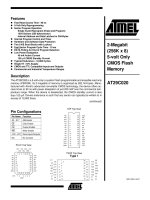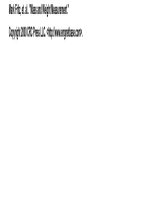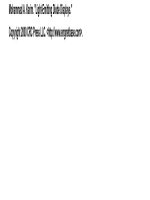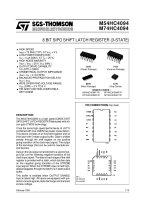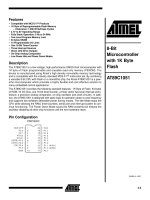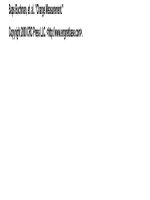Điện tử viễn thông ch61 khotailieu
Bạn đang xem bản rút gọn của tài liệu. Xem và tải ngay bản đầy đủ của tài liệu tại đây (186.61 KB, 11 trang )
G. H. Meeteen. "Refractive Index Measurement."
Copyright 2000 CRC Press LLC. <>.
61 Page 1 Thursday, January 7, 1999 3:07 PM
Refractive Index
Measurement
61.1 Introduction
61.2 Physical Principles
61.3 Techniques
Interferometry • Deviation Methods • Critical Angle Method •
Index Match Method • Microscopy and Scattering Methods •
Anisotropic and Heterogeneous Materials
G. H. Meeteen
Schlumberger Cambridge Research
61.4 Review of Refractometers
References
61.1 Introduction
Light is electromagnetic radiation of wavelength about 450 to 700 nm, in which region the human eye
is sensitive and refractive index measurements are commonly made. The refractive index or indices of a
substance describe an important part of its interaction with electromagnetic radiation. Refractive index
is a dimensionless quantity, real for transparent materials and complex if there is absorption. It generally
depends on the direction of light relative to axes of the material; such substances, e.g. many crystals, are
anisotropic and possess more than one refractive index. In general, the index is a tensor (3 ´ 3 matrix)
with up to 9 components. Many substances are isotropic, e.g., liquids, glasses, and other noncrystalline
materials, and one refractive index is sufficient. Some substances are optically inhomogeneous and possess
refractive index fluctuations over distances comparable in size with a wavelength. They scatter light and
appear milky or turbid. Many foodstuffs and drinks are optically heterogeneous. Refractometry is,
fortunately, a robust technique in the face of material complexities. It has widespread application to many
industries and materials. This chapter treats the refractive index as the principal measurand; the complications of real materials may require extra attention. Excluded are strongly absorbing materials such
as metals in which absorption may be more important than refraction. The appropriate measurement
technique is then ellipsometry, in which the amplitude and phase of the reflected light are measured, as
the polarization and the angle of incidence are varied. Some refractometric methods are essentially
ellipsometric, but for transparent samples transmission methods are also important. Refractive index
measurements of high precision, e.g. 10–4 to 10–5, are possible with relatively simple techniques. Although
ocular instruments remain popular, semiconductor technology has been applied to refractive index
measurement in recent years, improving the measurement speed and precision. One of the limits to
improvement in precision is the sample’s absorption or heterogeneity, a factor considered herein. Several
online instruments exist, and the application of refractive index measurements to complex industrial
fluids has been recently described [1]. Fiber-optical methods do not yet possess the precision of conventional methods but offer the possibility of remote sensing.
© 1999 by CRC Press LLC
61 Page 2 Thursday, January 7, 1999 3:07 PM
Refractive index is measured for many reasons. It is clearly important to know the refractive index of
materials used for their clarity, such as glasses and solid plastics. In complex fluids such as drinks or
foods, the refractive index is a measure of dissolved or submicronic material. The Brix scale relates
refractive index to sugar concentration. Common industrial applications are to microemulsions to measure their oil/water ratio, to antifreeze to check the glycol/water ratio, and to inaccessible liquids such as
the electrolyte of rechargeable cells [2]. The clinical applications of light have stimulated interest in
biotissue refractometry [3], and refractometry is useful for the analysis of small samples of biofluids.
61.2 Physical Principles
The electromagnetic nature of light and the atomic origin of refraction are described herein only in
enough detail to be useful to refractometry; detailed descriptions of them are readily found in optics
textbooks [4].
Monochromatic light can be described as an electromagnetic radiation of frequency n (Hz) and freespace wavelength l0. In free space (vacuum), the phase velocity c0 is given by c 0 = nl 0 . In a medium
or material substance, the phase velocity changes to c = nl , the refractive index n of that substance
then being defined as n = c 0 ¤ c . As the frequency is unchanged by entering the medium, n = l 0 ¤ l .
In an electromagnetic wave, the vibration directions of the electric and the magnetic fields are 90° apart,
and both fields vibrate at 90° to the wave’s direction of propagation. In transparent and nonmagnetic
materials, refractive index is determined primarily by the interaction of the electric field of the wave with
the permittivity e of the medium. This quantity is written as e = e r e 0 , where er is the relative permittivity
7
–1
2
of the medium, and e0 is the permittivity of free space being 10 ¤ ( 4pc 0 )F m , or about 8.854 pF m–1.
In the wave theory of light, er is determined by the strength of elastic interaction between the wave’s
electric field and the bound charges (electrons and protons) in the atoms and molecules of the medium.
For nonmagnetic transparent materials, n = e r can be shown if both quantities are measured at the
same frequency, and this relation is also closely true if the absorption is weak. Absorption can be ascribed
to the inelasticity of the interaction of the wave’s electric field with the bound charges, some of the wave’s
energy being turned to heat during propagation.
The time (t) and distance dependence of the electric field E of a wave propagating in the z direction
can be written
E = E 0 exp i ( wt – k 0 z )
(61.1)
where w = 2pn = the pulsatance or angular frequency, k 0 = 2p ¤ l 0 = the free-space wave number,
and i = – 1 . The field E in Equation 61.1 is complex, and the physical field is understood to be the
real part of the complex one, i.e. E = E 0 cos ( wt – k 0 z ) . The wave amplitude E0 is the maximum
excursion of E, both quantities being coparallel and normal to the direction of propagation z. The optical
power per unit area (radiance) conveyed by the wave is proportional to |E|2, or also |E0|2. The phase
velocity c is given by w/k, which the above relations show to be c 0 ¤ n . Waves in absorbing media are
attenuated as z increases. This is described by a complex refractive index in Equation 61.1, i.e., writing
n = n¢ – n² so that the field oscillates in space and time as before, but decays exponentially with
propagation distance z as ( – k 0 n²z ) . The cause of the index n² may be absorption, scattering, or both.
It will be clear from context whether n refers to the real part of the complex quantity, or to the complex
quantity itself. For the most part, this chapter deals with transparent or only slightly absorbing materials,
where n² is very small.
Equation 61.1 shows that n determines the phase of a wave, and this is the basis of the interferometric
methods of refractometry, most used for either highly precise measurements on liquids or solids, or for
gases where the refractive index is close to 1. Other common refractometric methods rely on the reflection
or transmission of light at the interface between the sample and a material of known refractive index.
Reflection and refraction of light at optically smooth interfaces are treated (Fresnel relations) in optics
textbooks. A description follows that should suffice for the experimental refractometrist.
© 1999 by CRC Press LLC
61 Page 3 Thursday, January 7, 1999 3:07 PM
FIGURE 61.1 Light beams reflected (R)
and transmitted or refracted (T) at the
interface between two refractive indices, n1
and n2, the second being greater than the
first.
Simple laws apply to the incident, reflected, and transmitted
beams at a planar interface between two transparent media.
For brevity, we consider only isotropic media. A parallel-collimated incident light beam produces a parallel-collimated
reflected and transmitted beam. All beams are coplanar and
define a plane of incidence, which is orthogonal to the planar
interface. The interface normal also lies in the plane of incidence. Figure 61.1 shows the incident, reflected, and transmitted beams in the plane of incidence. In the first medium, the
angle of incidence and reflection made to the interface normal
are equal; both q1. The angle of transmission q2 into the second
medium is given by Snell’s law
n 1 sin q 1 = n 2 sin q 2
(61.2)
where the subscripts refer to the first and second medium. If
n1 is known and the angles are measured, n2 can be obtained.
Equation 61.2 is the basis of deviation refractometry, q. v.
If n 1 > n 2 , Equation 61.2 shows that real angles of transmission do not exist for q 1 > arcsin ( n 2 ¤ n 1 ) ;
i.e., q2 is imaginary. The incident and reflected beams are then of equal power, transmitted light is absent,
and the reflection is said to be total. However, although in the second medium no wave propagates, there
is an evanescent wave close to the interface, which is nonpropagating and therefore transmits no power.
The critical angle is given by
n1
q c = arcsin æ -----ö
è n 2ø
(61.3)
(See Figure 61.2.) Reversing the light direction, Figure 61.3 shows that a beam traveling parallel to the
interface in the least refractive index medium enters the second medium at a transmission angle also
given by qc. A full analysis (Fresnel’s equations) shows that, in the region of the critical angle, the reflected
or transmitted optical power changes very rapidly with angle of incidence. If there is no absorption, there
is actually a discontinuity of reflected or transmitted radiance at qc. This makes qc easy to measure
accurately and gives the critical angle or Abbe method of refractometry used by most commercial
refractometers.
FIGURE 61.2 Total reflection at the critical
angle of the incident beam (I) in the first
medium of greater refractive index than the
second. No light is transmitted into the second medium for angles exceeding the critical
angle.
© 1999 by CRC Press LLC
FIGURE 61.3 Total refraction of incident beam (I) transmitted as beam T
into the medium of lesser refractive
index at the critical angle. No light
exists for angles in the second medium
bigger than the critical angle.
61 Page 4 Thursday, January 7, 1999 3:07 PM
The Fresnel laws of reflection at a plane interface between two media show that if the incident light
is linearly polarized with its electric field in the plane of incidence, then there is no reflected light at the
Brewster angle qB given by
n2
q B = arctan æ -----ö
è n 1ø
FIGURE 61.4 Light incident in the first medium
at the Brewster angle, and polarized with its electric vector parallel to the plane of incidence, is
transmitted (T) wholly into the second medium
with zero reflection R.
(61.4)
(See Figure 61.4.) Measurements of qB, usually in air (n1
close to 1), will give n2. The reflected optical power is zero
at qB and it increases approximately quadratically for
angles below and above qB. Consequently, the Brewster
angle method is regarded to be of lower precision than the
critical angle method, and so is relatively less used. However, unlike the critical angle method, it does not require
a reference medium of higher refractive index than the
sample.
If the sample is a finely divided particulate solid or has
an irregular interface, none of the preceding methods is
useful. Fresnel’s equations show the reflectance of any
shape of interface to be zero if the refractive index difference across the interface is also zero. In the method of
refractive index match, the turbidity or scattering from a
cloud of particles suspended in a liquid is measured, and
the refractive index of the liquid is found, which gives
minimum turbidity or scattering. The liquid should not
swell or interact with the interior of the solid.
61.3 Techniques
Interferometry
The sample, with parallel input and output faces, is put in the sample beam of a two-beam interferometer
(e.g. Rayleigh, Michelson, or Jamin). From Equation 61.1, a sample of length z and refractive index n
causes a phase lag of 2pnz ¤ l 0 , compared with 2pn air z ¤ l 0 for the reference beam in air. The phase
difference between the two beams is thus
2pz ( n – n air )
d = -----------------------------l0
(61.5)
The refractive index of air is 1 for approximate purposes, or is known more precisely [5]. Sample insertion
causes a step increment of d in the phase difference, which is measured by adjusting a calibrated phase
compensator in the reference beam to regain the zero-order fringe of white-light fringes. Equation 61.5
enables n to be calculated. For gaseous samples, use of the compensator may be avoided by allowing the
gas to enter an initially evacuated tube with rigid and parallel window faces placed in the sample beam.
As the gas enters slowly, the interference fringes passing a fudicial mark may be counted. Each whole
fringe corresponds to a change in d of p radian. The refractive index of a gas depends, through its density,
on pressure and temperature. The number of fringes between a vacuum (n = 1) and the gas at a given
pressure and temperature will then give the gas refractive index.
In interferometry, the effect of optical attenuation (via absorption or scattering) by a sample of complex
refractive index decreases the fringe brightness but does not affect the phase. Thus, only the real part the
complex refractive index is measured.
© 1999 by CRC Press LLC
61 Page 5 Thursday, January 7, 1999 3:07 PM
About 0.1 of a fringe can be judged by eye; electro-optic methods can measure 10–6 of a fringe. The
method’s potential precision is very high. However, an interferometer is delicate and expensive, and good
sample quality (homogeneity, face parallelism) is necessary. A difference in dispersion (wavelength
dependence) of the sample and compensator refractive index can be a problem. For a sufficiently large
number of fringes, the dispersion difference between the sample and compensator can make the whitelight fringe pattern and zero-order fringe invisible [6]. One solution is to use a compensator more closely
matched to the sample dispersion. A cheaper option is to reduce the sample length, with some loss of
precision. A major use of the interference method is for gases, where n – 1 is about 1000 times less than
n – 1 of solids and liquids. It is also used in solution differential refractometry, e.g. to measure the
concentration in the eluted solvent relative to the pure solvent. A stable folded Jamin interferometer for
refractive index measurements is described by Moosmüller and Arnot [7]. Liquid refractive index measurements using a Michelson interferometer are described by Richerzhagen [8].
Deviation Methods
Lateral and angular deviation methods make use of Snell’s law (Equation 61.2). The incident beam is
usually in air, of refractive index n air .
Lateral deviation l occurs for a beam of light transmitted
through a parallel-sided sample of thickness L (see Figure
61.5). If the incident angle is q air , Snell’s law (Equation
61.2) gives
æ cos q
ö2
n
air ÷
ç
------- = 1 + ------------------------ç
l÷
n air
è sin q air – ---ø
L
1
--2
sin q air
(61.6)
If q air and L can be measured the most accurately, the
precision of the method depends on the accuracy of measuring l. Modern electro-optic beam-displacement detection devices permit a precision of a few micrometers in l,
giving a typical precision in n of about 0.001. The lateral
FIGURE 61.5 Lateral deviation l of a light beam deviation method is suitable for samples in sufficiently
on passage through a parallel-sided refractile thick sheet form.
In the angular deviation method, parallel-collimated light
sample slab of thickness L.
is incident on one face of the sample of refractive index n
in triangular prism form with vertex angle A, the vertex line of the prism being normal to the plane of
incidence (see Figure 61.6). The exit beam deviates angularly from the direction of the incident beam. At
the angle of minimum deviation D, the analysis is simplest Equation 61.1, showing that
A+D
sin æ --------------ö
è 2 ø
n
------- = ---------------------------n air
A
sin æ ---ö
è 2ø
(61.7)
For A = 60°, a 1 minute (1´) uncertainty in D gives 0.0003 for the corresponding precision in n. Angular
deviation requires the sample to be a less convenient shape than the parallel-sided sheet of the lateral
deviation method. However, measurements of D and A can be made simply using an ocular goniometer.
Lateral or angular deviation methods can be applied to liquid samples in a suitable cell with walls having
parallel sides. Such cell walls will, however, give some lateral deviation but not cause angular deviation
if used to make a hollow prism to contain a liquid sample. In the Hilger-Chance angular deviation
© 1999 by CRC Press LLC
61 Page 6 Thursday, January 7, 1999 3:07 PM
FIGURE 61.6 Angular deviation D of a light beam on passage through a prism of vertex angle A. If the interior
beam forms an isosceles triangle with A at the vertex, then D is the angle of minimum deviation.
refractometer [9], the liquid sample is contained in a glass 90° V-block of refractive index n glass , with
parallel outer faces. A parallel-collimated light beam incident normally on one outer face of the block
suffers angular deviation D (not minimum), Equation 61.2, giving
2
n =
2
n glass
+
2
( n glass
2
1
--2
– sin D ) sin D
(61.8)
For a 1´ uncertainty in D, the precision in n is about 10–5. Solid samples can be measured by coupling a
prism of the sample into the V-block using a thin film of liquid of refractive index intermediate between
that of the sample and the prism.
Critical Angle Method
In the region of the critical angle, Fresnel’s equations show that the transmitted or reflected optical power
varies discontinuously with angle. Thus, q c is accurately measurable and a refractive index precision of
about 10–4 to 10–5 is obtained. Liquid samples are placed directly onto one face of the refractometer prism
of known refractive index. Solid samples need only one face to be flat and optically polished, which is
coupled to face of the refractometer prism using a liquid film of intermediate refractive index. For a
transparent sample, either the transmission or the reflection mode can be used, as q c is the same for
both (see Figures 61.2 and 61.3). In the transmission mode, the sample–prism interface is illuminated
diffusely through the sample, the critical angle then being the largest angle of transmission in the prism.
In the reflection mode, useful for highly scattering or absorbing samples, the prism–sample interface is
illuminated diffusely from within the prism. The critical angle is then where the reflectance changes
discontinuously with angle of reflection within the prism, being total for q ³ q c . In the transmission
mode, the transmittance from the sample into the prism is zero for q ³ q c and finite for q £ q c whereas,
in the reflection mode, typically a few percent of the light is reflected for q £ q c , and 100% is reflected
for q ³ q c . If the interface is illuminated with diffuse light, the transmission mode gives a dark–bright
contrast at the critical angle, with a dim–bright contrast for the reflection mode. For ocular observation,
this difference can make the transmission method preferable. Automatic instruments invariably use the
reflection mode, this being necessary for samples that attenuate by absorption or scattering. For such
samples, however, the discontinuity of reflectance is replaced by a continuous function with a maximum
gradient at an angle q max that differs increasingly from q c as the sample becomes more absorbing
[10–12]. A separate measurement of the absorption index is required before q c can be obtained from
q max . Attempts to improve the precision of critical angle refractometry of nontransparent samples are
expected to become increasingly limited by this effect.
© 1999 by CRC Press LLC
61 Page 7 Thursday, January 7, 1999 3:07 PM
The critical angle method, however, is robust and simple to use. Despite the problems associated with
optically attenuating samples, it is likely to persist as the preferred method in commercial refractometers.
Brewster Angle Method
Here, the angle of reflection q B is measured for which there is no linearly polarized light reflected from
the sample surface. Equation 61.4 then gives the sample refractive index, where n1 is the refractive index
of the medium containing the incident and reflected light, usually air. The light is polarized such that
its electric field vector vibrates parallel to the plane of incidence (see Figure 61.4). A linearly polarized
laser is a suitable source of monochromatic light. Nonpolarized sources require polarizing with a GlanThomson prism or a quality dichroic polarizer. With a 1 mW HeNe laser and ocular judgement of the
minimum reflectance, a precision in q B of about 0.1° can be obtained, giving a precision in the sample
refractive index of about 0.005. Precision improvement by factors of 10 to 100 can be expected if
photometric analysis replaces the eye. The Brewster angle method is then comparable in precision to the
critical angle method. Unlike the critical angle method, however, it does not require a reference material
of higher refractive index than the sample. If the sample is absorbing, the reflectance zero at q B is replaced
by a reflectance minimum at an angle q min . It can be shown that a given absorption produces less error
in the Brewster angle method than in the critical angle method [6, 12]. Despite these good features of
the Brewster angle method, a commercial Brewster angle refractometer is not known to this author.
Index Match Method
The refractive index match method does not require the sample to be in any special shape or form. Thus,
it might be finely divided, i.e., a powder. Assuming the particles to be isotropic and homogeneous, then
the reflected radiance, the angular or lateral deviation, and the relative phase shift of transmitted light
all become zero at refractive index match. If the sample is absorbing, the refractive index of the surrounding liquid which gives the minimum visibility still gives closely the real part of the sample’s refractive
index. Similarly, if the sample is heterogeneous or anisotropic, the method gives the average refractive
index of the sample. The liquid should not dissolve, permeate, or react in any way with the solid sample.
For macroscopic samples a precision of about 0.005 in n has been estimated [6] from the index-match
method, where a simple ocular estimation of match is employed. For a matching liquid of refractive
2
index nliq, the reflectance from an interface varies approximately as ( n – n liq ) . This quadratic dependence
makes the sensitivity of the method decrease as the match is approached, and makes it difficult in practice
to judge whether nliq should be increased or decreased to improve the match.
Microscopy and Scattering Methods
The refractive index of individual particles large enough to image in a microscope can also be measured
by the index-match method. Central or oblique illumination modes can be used corresponding to the
Becke, and Schroeder-Van der Kolk methods, respectively, which utilize null deviation at refractive index
match. A precision of 0.0002 in n is quoted [13] for the Becke line method. Whether nliq is lesser or
greater than the sample’s refractive index n is shown by the appearance of the image.
The phase difference between light transmitted through and around the particle is proportional to
n – n liq , so that the phase changes sign each side of match. This is used in measurement of refractive
index of particles by phase-contrast or interference microscopy, in which the image is brighter or darker
than the background according to whether n > n liq or n < n liq . These methods can measure the refractive
index of particles below the conventional resolving limit, as the details of an object need not be fully
resolved in order to discern match or otherwise. Users of microscopy in refractometry should refer to
texts on phase-contrast and interference microscopy. Newer forms of optical microscopy (e.g., scanning
confocal) have greater resolving power and can be used for refractive index matching of finer particles.
For a suspension of particles smaller than about 1 µm, the optical turbidity and light scattering are
zero at refractive index match, leading to turbidimetric or nephelometric methods of measuring the
© 1999 by CRC Press LLC
61 Page 8 Thursday, January 7, 1999 3:07 PM
particle refractive index. For particles of colloidal size, it is important to avoid aggregation or flocculation,
and suspension destabilization. Thus, chemical restrictions can preclude the attainment of match, particularly if the particle’s refractive index is large compared with nliq. In such cases, the turbidity E is
measured for changes in nliq which do not destabilize the suspension, and the value of nliq is found by
extrapolation to E = 0. Extrapolation to obtain this value of nliq is difficult unless the experimental
parameters can be arranged to have a linear relation. Theory and experiments described by Griffin and
Griffin [14] showed that linearity is obtained if nliq E is plotted versus nliq.
Anisotropic and Heterogeneous Materials
If a plane face is made from a general optically anisotropic sample, and this face is then offered to the
prism of a critical angle refractometer, two critical angles can be simultaneously observed. One can be
enhanced over the other through the use of a linear polarizer rotated in the incident or refracted light
path. The interpretation of these critical angles, in the general case, is not simple, and the reader is
referred to analyses [15–17]. Similar complexity is visited upon the Brewster angle method if the sample
is anisotropic, and again the reader is referred to Reference 6 for works on ellipsometry.
Highly turbid samples, such as polymer latexes and other concentrated colloidal fluids, have been
investigated using the critical angle method [1, 18–20]. It appears that if the particle size is less than
about half a wavelength, the critical angle method remains successful for volume fractions up to at least
0.5. For high concentrations of larger particles, there is a rapid degradation of the reflectance or transmittance discontinuity at the critical angle. This angle is replaced by a region where the reflectance or
transmittance may vary in an unexpected way as the particle size and concentration increase.
The effect of heterogeneity on the reflection of polarized light, and on the Brewster angle, is also
affected by sample heterogeneity [21, 22]. Whereas for a homogeneous sample the parallel-polarized
reflectance at the Brewster angle is zero, the effect of sample heterogeneity on the wavelength scale is to
cause finite reflectance. Comparison of the Brewster angle and the critical angle methods for heterogeneous materials awaits investigation.
Gate and coworkers have measured the refractive index of emulsion paint films [23] and coated paper
[24] by a non-Brewster angle reflection method. Both materials were strongly heterogeneous on the
wavelength scale and so (in air) had a strong nonspecular or diffuse reflectance. Some specular reflection
remained, however, and the method derives the refractive index of the surface of the film from the ratio
of the specular reflectances at a non-Brewster angle for polarizations parallel and normal to the plane of
incidence.
The application of refractometry to heterogeneous and absorbing samples is clearly a developing art
and, although it is clear that refractometry offers valuable information, the refractometrist should use
existing instruments critically.
61.4 Review of Refractometers
The author’s initial review of refractometer manufacturers revealed about 30 companies, and the true
number may be more than 50. A very large number of general- and special-purpose instruments are
offered by each company, e.g., 31 different models by the Atago Co., Ltd. It is clearly not possible to
review, compare, and advise on individual models. The aspiring refractometrist should do this according
to needs and budget. The generalities that follow should assist.
Most instruments use the critical angle (or Abbe) method. They thus have a prism of known refractive
index with a face to which the sample is offered. The larger manufacturers offer three types of critical
angle instrument:
1. The portable hand-held models, which require no power or battery and are customized and
calibrated for Brix (sugar), urine, antifreeze, cutting oil, etc. Their refractive index precision is
typically between 10–3 and 10–4, but their range is small owing to their particular application. The
user looks into an eyepiece and reads a scale on which is superposed the dark–light boundary
© 1999 by CRC Press LLC
61 Page 9 Thursday, January 7, 1999 3:07 PM
caused by transmission or reflection in the region of angle each side of the critical angle; often
termed the critical edge. The price varies greatly between models and manufacturers, typically
U.S. $200 to $400.
Some manufacturers offer a digital readout portable models, of similar weight (less than 1 kg)
and precision, and battery powered. These cost roughly U.S. $1000 to $2000.
2. The laboratory (Abbe) refractometer, which has a refractive index precision of typically 10–4 to
10–5 and covers a wide range of refractive index, typically 1.3 to 1.75 in a low refractive index
instrument, and 1.4 to 1.85 in a high refractive index model. Such instruments are calibrated so
that the temperature can be varied using an external liquid bath, and the wavelength can be varied
using external light sources. Very roughly, their weight, cost, and precision are about 10 times that
of the portable instruments in (1) above. They require the user to estimate the position of the
critical edge on a graduated scale viewed through an eyepiece.
3. The digital refractometer. Compared with those in (2) above, these have similar precision and
general facilities, a cost typically a few times greater, but with the advantage of a digital or electronic
readout of the data. The upper refractive index offered by several manufacturers appears to be
restricted to about 1.55.
4. The process refractometer is a version of those described in (3) above, but where the prism is
mounted to contact a fluid in a reactor or a pipe, and viewed via a fiber-optic cable. Thus, high
pressures and temperatures can be accommodated. The prism is usually of sapphire to avoid wear
of the optical face, and the precision generally tend to be somewhat lower than those described
in (2) and (3) above.
References
1. M. Mohammadi, Colloidal refractometry: meaning and measurement of refractive index for dispersions; the science that time forgot, Adv. Colloid Interface Sci., 62, 17–29, 1995.
2. J. E. Geake and C. Smalley, A simple linear hand-held refractometer, J. Phys. E: Sci. Instrum., 16,
608–610, 1983.
3. H. Li and S. Xie, Measurement method of the refractive index of biotissue by total internal
reflection, Applied Optics, 35, 1793–1795, 1996.
4. M. Born and E. Wolf, Principles of Optics, 6th ed., Oxford: Pergamon, 1980.
5. P. E. Ciddor, Refractive index of air: new equations for the visible and near infrared, Applied Optics,
35, 1566–1573, 1996.
6. G. H. Meeten, Refraction and extinction of polymers, in Optical properties of polymers, Ed. G. H.
Meeten, London: Elsevier Applied Science, 1986.
7. H. Moosmüller and W. P. Arnott, Folded Jamin interferometer: a stable instrument for refractive
index measurements, Optics Lett., 21, 438–440, 1996.
8. B. Richerzhagen, Interferometer for measuring the absolute refractive index of liquid water as a
function of temperature at 1.064 µm, Applied Optics, 35, 1650–1653, 1996.
9. R. S. Longhurst, General and Physical Optics, 3rd ed., London: Longmans, 1973.
10. G. H. Meeten, A. N. North, and F. M. Willmouth, Errors in critical-angle measurement of refractive
index of optically absorbing materials, J. Phys. E: Sci. Instrum., 17, 642–643, 1984.
11. P. R. Jarvis and G. H. Meeten, Critical angle measurement of refractive index of absorbing materials,
J. Phys. E: Sci. Instrum., 19, 296–298, 1986.
12. G. H. Meeten, Refractive index errors in the critical-angle and Brewster-angle methods applied to
absorbing and heterogeneous materials, Meas. Sci. Technol., 8, 728–733, 1997.
13. C. P. Saylor, Advances in Optical and Electron Microscopy, Vol. 1, Ed. R. Barer and V. E. Cosslett,
London: Academic Press, 1966.
14. M. C. A. Griffin and W. G. Griffin, A simple turbidimetric method for the determination of the
refractive index of large colloidal particles applied to casein micelles, J. Colloid Interface Sci., 104,
409–415, 1985.
© 1999 by CRC Press LLC
61 Page 10 Thursday, January 7, 1999 3:07 PM
15. F. Yang, G. W. Bradberry, and J. R. Sambles, A method for the optical characterization of thin
uniaxial samples, J. Modern Optics, 42, 763–774, 1995.
16. F. Yang, G. W. Bradberry, and J. R. Sambles, Critical edge characterization of the optical tensor of
a uniaxial crystal, J. Modern Optics, 42, 1241–1252, 1995.
17. F. Yang, J. R. Sambles, and G. W. Bradberry, A simple procedure for characterizing uniaxial media,
J. Modern Optics, 42, 1477–1458, 1995.
18. G. H. Meeten and A. N. North, Refractive index measurement of turbid colloidal fluids by transmission near the critical angle, J. Meas. Sci. Technol., 2, 441–447, 1991.
19. J. E. Geake, C. S. Mill, and M. S. Mohammadi, A linear differentiating refractometer, J. Meas. Sci.
Technol., 5, 531–539, 1994.
20. G. H. Meeten and A. N. North, Refractive index measurement of absorbing and turbid fluids by
reflection near the critical angle, J. Meas. Sci. Technol., 6, 214–221, 1995.
21. E. K. Mann, E. A. van der Zeeuw, Ger J. M. Koper, P. Schaaf, and D. Bedeaux, Optical properties
of surfaces covered with latex particles: comparison with theory, J. Phys. Chem., 99, 790–797, 1995.
22. E. A. van der Zeeuw, L. M. C. Sagis, and Ger J. M. Koper, Direct observation of swelling of noncross-linked latex particles by scanning angle reflectometry, Macromolecules, 29, 801–803, 1996.
23. L. F. Gate and J. S. Preston, The specular reflection and surface structure of emulsion paint films,
Surface Coatings International, 8, 312–330, 1995.
24. L. F. Gate and D. J. Parsons, The specular reflection of polarised light from coated paper, Products
of Papermaking: Transactions of the Tenth Fundamental Research Symposium held at Oxford: September 1993, Vol 1, 263–283, Leatherhead: Pira International 1994.
© 1999 by CRC Press LLC

